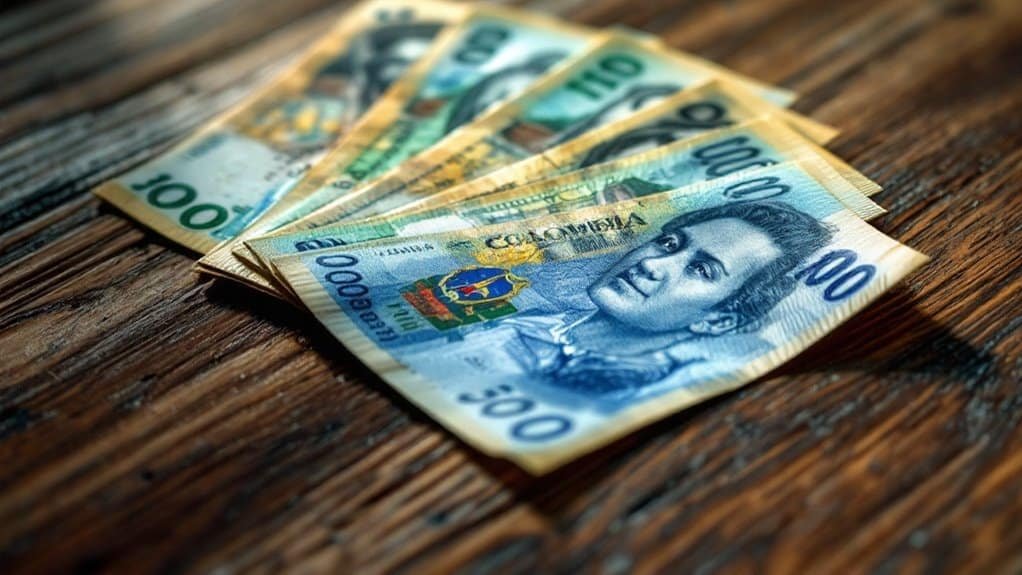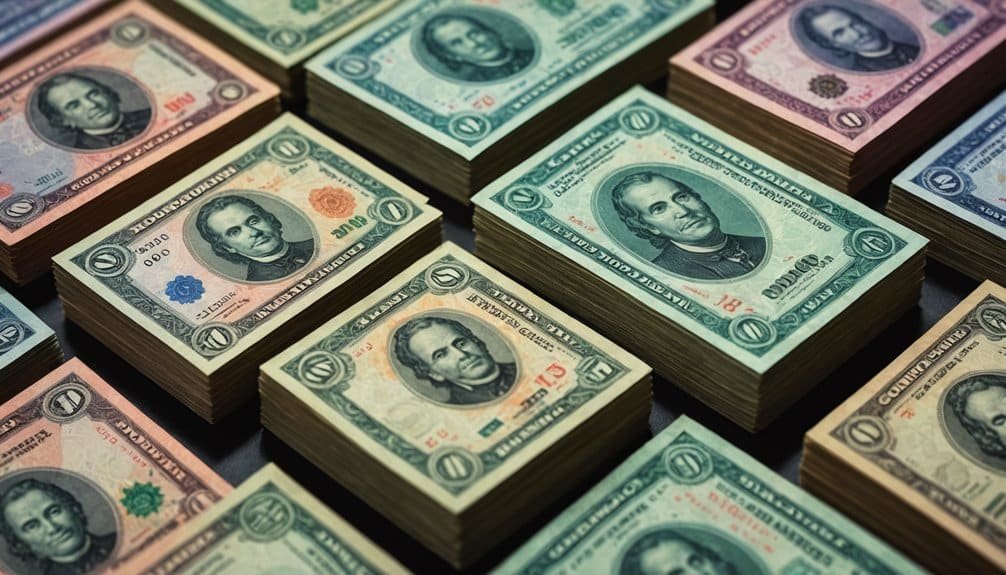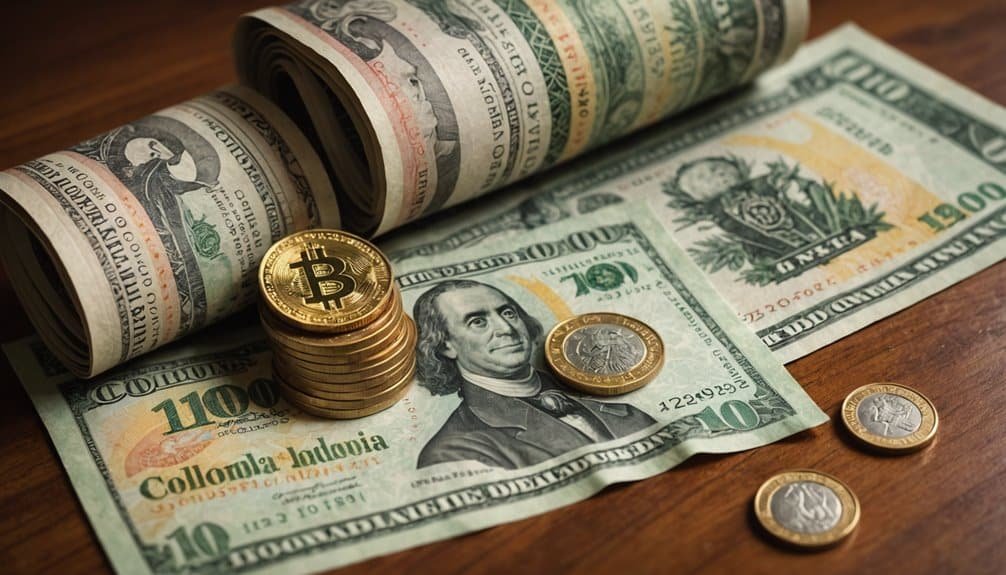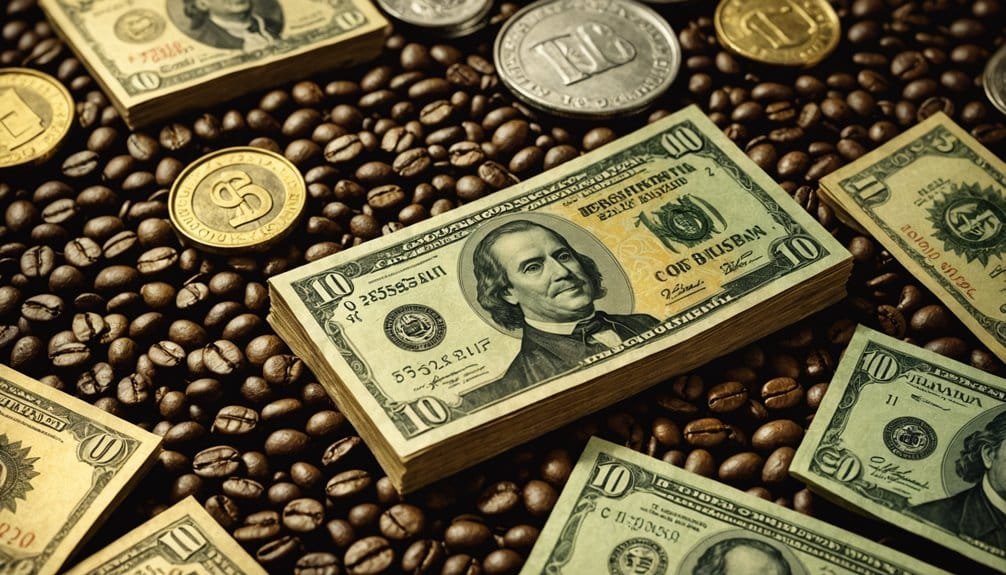
The Colombian Peso (COP) is your gateway to understanding Colombia's economic landscape. Originating in 1837, this currency reflects the nation's journey from colonial dependence to financial sovereignty. You'll find banknotes ranging from 2,000 to 100,000 pesos, showcasing cultural icons and biodiversity. Managed by Banco de la República, the peso's value fluctuates with global commodity prices, particularly oil. With a GDP growth of 2.1% in Q2 2024 and strategic export relationships with the US, China, and Panama, the peso represents more than just money—it's a dynamic economic narrative waiting to unfold.
Key Takeaways
- The Colombian Peso (COP) originated in 1837, replacing the Spanish colonial real and symbolizing economic independence after Colombia's liberation.
- Colombian banknotes range from 2,000 to 100,000 pesos, featuring cultural icons, landscapes, and advanced security features to prevent counterfeiting.
- Banco de la República manages currency issuance, implements monetary policy, and uses interest rate adjustments to stabilize economic health.
- The peso's value is significantly influenced by global oil prices, with mineral fuels comprising over 50% of Colombia's total exports.
- International trade dynamics, particularly with the United States (accounting for 28.1% of exports), play a crucial role in the currency's performance and stability.
Origins of the Colombian Currency
The origins of the Colombian peso trace back to three pivotal historical moments: Colombia's declaration of independence from Spain in 1810, the systematic replacement of the Spanish colonial real, and the subsequent establishment of a national monetary system.
The Central Bank's establishment played a crucial role in regulating and stabilizing the emerging national currency framework.
This currency evolution reflected Colombia's emerging national identity, transforming from a colonial economic structure to an independent financial framework. By 1837, the peso was officially introduced, marking a significant milestone in the country's historical significance.
The initial monetary system was deeply influenced by Spanish colonial practices, with the peso initially divided into 8 reales and later shifted to 100 centavos by the early 1860s.
These foundational changes represented more than a mere currency shift; they symbolized Colombia's economic sovereignty and institutional development during a critical period of national transformation.
Banknotes and Coin Denominations
When exploring Colombia's currency, you'll find a diverse range of banknote and coin denominations that reflect the country's rich cultural and natural heritage.
The Colombian peso features banknotes from 2,000 to 100,000 pesos, each showcasing notable personalities and stunning landscapes, while coins from 50 to 1,000 pesos highlight the nation's unique wildlife through intricate designs.
These denominations aren't just currency, but storytelling canvases that incorporate advanced security features to prevent counterfeiting and celebrate Colombia's biodiversity. The Central Bank's regulatory oversight ensures that each piece of currency maintains its integrity and represents the nation's economic standards.
Current Peso Denominations
The Bank of the Republic plays a crucial role in managing and regulating the Colombian peso's circulation and monetary policy.
Design and Security
Colombia's peso banknotes represent more than mere monetary exchange—they're sophisticated security instruments meticulously designed to combat counterfeiting while celebrating national identity.
You'll discover banknote aesthetics that showcase color-changing elements, like the Anón fruit shifting from green to blue and security innovations that make forgery remarkably challenging. Each denomination features unique cultural representations, with security strips and hexagons that dynamically alter colors when viewed from different angles.
The Banco de la República employs rigorous production processes, utilizing imported security paper and exclusive inks. The widespread presence of counterfeit currency risks in Colombia has further accelerated the development of increasingly complex security features.
Advanced technological checks—both automated and manual—ensure each banknote's integrity. Color-dependent security features, including elements that transform from gold to green, provide multiple verification layers, making Colombian currency a proof of cutting-edge monetary design and security engineering.
Coin Usage Patterns
Within Colombia's dynamic monetary landscape, peso coins and banknotes represent more than mere transactional tools—they're intricate financial instruments spanning diverse denominations.
When traversing coin usage patterns, you'll find that denominations ranging from 50 to 1,000 pesos facilitate small transactions across urban and rural settings. Coin acceptance remains widespread, with merchants readily embracing these metal currencies for everyday purchases.
Your transaction strategy should prioritize smaller denominations, as larger bills can be challenging to break. The absence of centavos since 1984 has streamlined coin interactions, making precise payments more straightforward.
While ATMs provide convenient access to cash, understanding coin circulation patterns helps travelers and locals alike optimize their financial interactions in Colombia's vibrant economic ecosystem. The copper and nickel alloys used in modern coin minting reflect Colombia's adaptive approach to currency production and economic sustainability.
Central Bank's Monetary Role

The Banco de la República's monetary role stands as the cornerstone of Colombia's financial governance, wielding critical tools to stabilize the nation's economic landscape. Currency issuance and management represent a fundamental mechanism through which the central bank maintains national financial equilibrium.
Through strategic interest rate adjustments and monetary policy tools, the central bank manages the Colombian peso's stability and economic health.
You'll find its approach thorough: controlling money supply, regulating exchange rates, and implementing open market operations to manage inflation.
Historical Currency Transformations
Since Colombia's independence in 1810, the nation's currency has undergone profound transformations, reflecting its economic evolution and national identity. The Spanish colonial real gave way to the Colombian peso in 1837, marking a significant currency evolution.
Provincial banknotes proliferated between 1857 and 1880, demonstrating regional monetary diversity. The gold standard's adoption in 1871 and subsequent linkage to the US dollar in 1931 showcased the peso's adaptability to global economic shifts.
Key peso impacts included the Bank of the Republic's creation in 1880, which centralized currency production, and the progressive introduction of higher denominations. The current exchange rate fluctuations, particularly the peso's global valuation, highlight the ongoing economic dynamics of Colombia's monetary system.
Monetary reforms, such as dropping the "oro" designation in 1993 and introducing biodiversity-themed banknotes in 2016, symbolized Colombia's economic maturation and cultural narrative.
Economic Performance and Challenges

Colombia's monetary evolution parallels its economic trajectory, with the peso's performance reflecting broader national economic dynamics.
You'll notice significant economic indicators revealing a complex landscape: GDP grew 2.1% in Q2 2024, then slowed to 2.0% in Q3, signaling volatility.
Investment trends paint a nuanced picture, with total investment declining 1.3% compared to 2023 and private sector investment losing 2.4%.
The economic challenges are multifaceted. Foreign currency inflows dropped 2.3%, driven by a substantial 28.6% decrease in foreign direct investment.
Fiscal risks loom, with the deficit projected at 5.6% of GDP and potential tax revenue shortfalls.
External shocks, including geopolitical tensions and commodity price fluctuations, further complicate Colombia's economic resilience, demanding strategic monetary and fiscal adaptation.
The entertainment sector's remarkable 23.7% growth surge provides a bright spot amid these economic challenges, demonstrating the potential for dynamic economic recovery in specific industries.
Foreign Exchange Trading Insights
Trading the Colombian Peso unravels a complex landscape of economic dynamics and global market influences. When developing forex strategies, you'll need to navigate significant currency volatility driven by multiple factors:
- Monitor oil price fluctuations, which critically impact the Peso's value.
- Watch Central Bank interventions and monetary policy shifts.
- Track global risk appetite and international investment trends.
- Analyze U.S. Federal Reserve rate decisions.
Your trading approach must integrate thorough insights from historical exchange rate movements and forward-looking projections. Recent exchange rate data shows the Peso's marginal daily decline of -0.03%, underscoring the need for real-time market analysis.
The Peso's sensitivity to external economic conditions means you'll need a nuanced strategy that accounts for geopolitical uncertainties, commodity market trends, and macroeconomic indicators.
Successful trading requires adaptability and a keen understanding of the interconnected global financial ecosystem that influences Colombia's currency performance.
Export Landscape and Global Trade

The remarkable breadth of Colombia's export ecosystem reveals a dynamic landscape shaped by strategic commodities and global market interactions. You'll find that mineral fuels dominate, accounting for over 50% of total exports, with crude oil and coal driving significant revenue. Services exports contribute substantial economic value of 13.48 billion US dollars, indicating the sector's significant role in the national economic structure.
The United States stands as Colombia's primary trade partner, absorbing 28.1% of exports, followed by China and Panama.
Your understanding of Colombia's trade dynamics should recognize its impressive 17.77% trade growth, outpacing global trends. While the country experiences a negative trade balance, its export sectors demonstrate resilience, with emerging categories like electrical machinery and aluminum showing promising expansion.
These trade relations highlight Colombia's strategic positioning in regional and global markets, underscoring its economic adaptability and potential for diversification.
Future Monetary Policy Directions
Against the backdrop of evolving economic dynamics, BanRep's monetary policy trajectory signals a calculated approach to managing inflation and supporting economic recovery.
You'll want to track these key insights into future monetary policy:
- Interest rate trends suggest continued gradual reduction, with expectations of rates dropping to 8.75% by year-end and potentially 6.75% in Q1 2025.
- Inflation forecasts indicate a slow convergence towards the 3% target, with market expectations stabilizing around 3%.
- BanRep remains committed to balancing inflation control with economic growth stimulation.
- External factors like U.S. monetary policy and global economic conditions will markedly influence policy decisions.
The central bank's nuanced strategy reflects a delicate balancing act: managing inflationary pressures while providing economic stimulus through strategic interest rate adjustments and maintaining a forward-looking monetary policy approach. Rate cut decision represents a critical turning point in Colombia's monetary policy strategy, signaling the central bank's confidence in managing economic challenges.
Conclusion
The Colombian peso's journey reflects a complex economic narrative, where volatility and resilience intersect. As global markets shift and Colombia's economic landscape evolves, you'll find the peso's trajectory both challenging and fascinating. Will strategic monetary policies stabilize its value? Only time will reveal the currency's true potential in an increasingly interconnected global financial ecosystem.







Interesting read, but how does the Colombian Peso stand against inflation? With such a diverse range of denominations, is there a correlation with economic stability? Just food for thought.
Interesting read! Just wondering, why does the Colombian government not consider using a different currency to tackle their inflation issues? Would a currency switch be more beneficial?
Currency switch? Easy to suggest, complex to implement. Its not a magic fix for inflation.
Interesting read, but arent we missing the part about how the exchange rate fluctuates and impacts the economy? A lot of focus on the history, but what about the present dynamics?